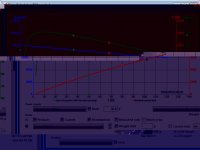So, we see RC motors used for high-power, but there's also a good application for low-power, long-range. If it can handle 2000W for half an hour or an hour, it can definitely handle 500-1000W for a day.
Matt's recumbent gets excellent range, and 14Wh/mile IIRC, but I don't think that's the max.
The Astroflight motors get 93% efficiency at about 1.3kW and drop to 90% as it approaches max speed/torque/power.
What are these motors like before these high power outputs? Does anybody have some nice charts? If these motors are 90% +/- 6%, is there any benefit of gears?
There's enough power on these things to accelerate from a stop, but still get a max speed of 60-120km/h (~37-74mph), so is gearing worth it for long-distance?
How do you measure your efficiency?
Gearing the 6-turn AstroFlight 3210 at 48V down to 40km/h (25mph) takes a lot, especially on a 700c wheel (my current situation). Does using 48V make up for the mechanical loss of reducing by 2, over 24V?
I'm asking this for two reasons: personal interest, and R/C e-bikes are approaching car speeds, car horsepower ratings, and automotive quality (in a good way, not a Ford-quality way). Now, e-cars have the problem of range, but I see no reason why we can't be hitting 20-30mph for 10-12 hours. I personally have a 420mile trip I'd like to make by e-bike over two days.
What's needed in motor and battery efficiency for a practical car replacement, even if half speed?
Matt's recumbent gets excellent range, and 14Wh/mile IIRC, but I don't think that's the max.
The Astroflight motors get 93% efficiency at about 1.3kW and drop to 90% as it approaches max speed/torque/power.
What are these motors like before these high power outputs? Does anybody have some nice charts? If these motors are 90% +/- 6%, is there any benefit of gears?
There's enough power on these things to accelerate from a stop, but still get a max speed of 60-120km/h (~37-74mph), so is gearing worth it for long-distance?
How do you measure your efficiency?
Gearing the 6-turn AstroFlight 3210 at 48V down to 40km/h (25mph) takes a lot, especially on a 700c wheel (my current situation). Does using 48V make up for the mechanical loss of reducing by 2, over 24V?
I'm asking this for two reasons: personal interest, and R/C e-bikes are approaching car speeds, car horsepower ratings, and automotive quality (in a good way, not a Ford-quality way). Now, e-cars have the problem of range, but I see no reason why we can't be hitting 20-30mph for 10-12 hours. I personally have a 420mile trip I'd like to make by e-bike over two days.
What's needed in motor and battery efficiency for a practical car replacement, even if half speed?


